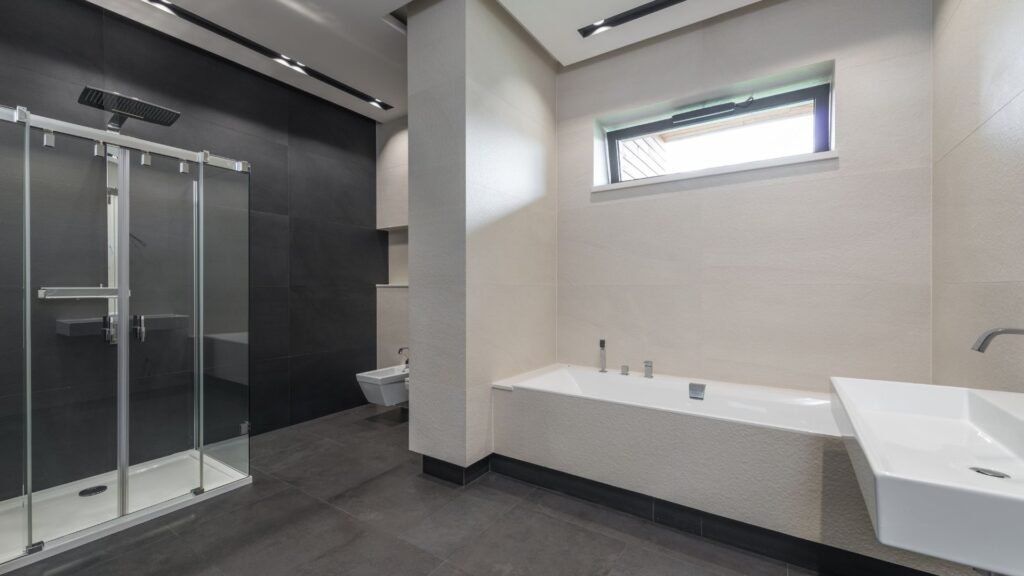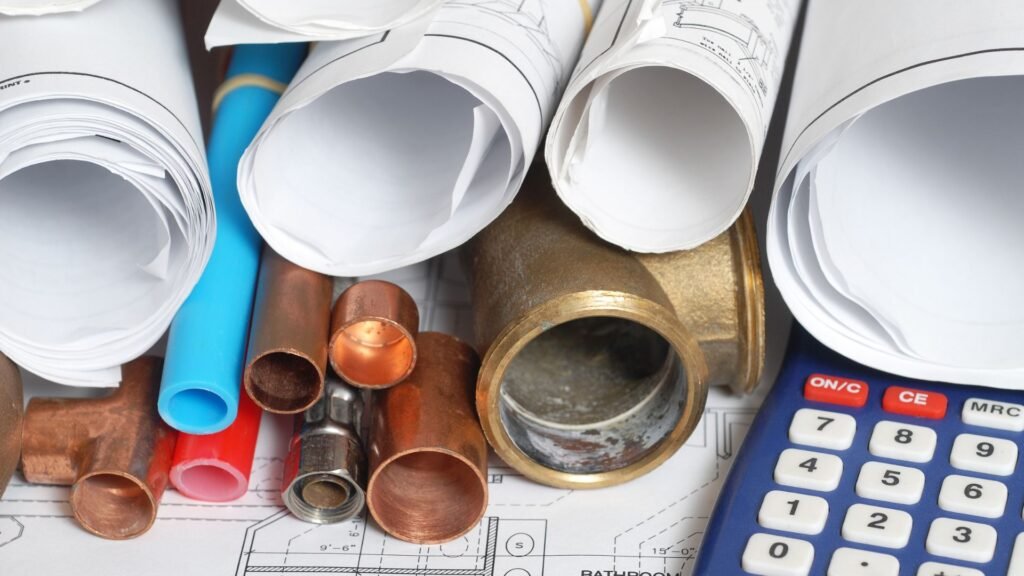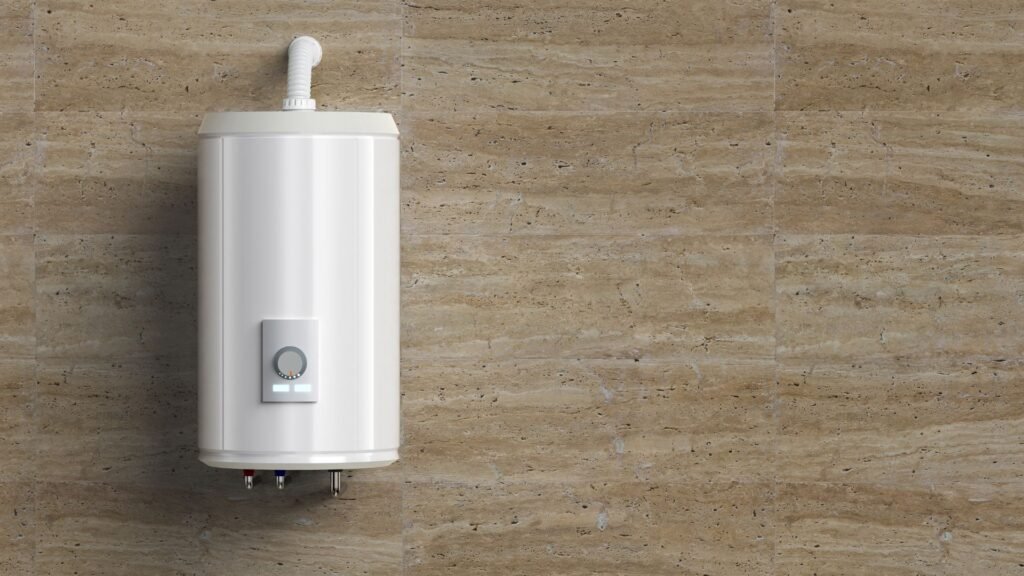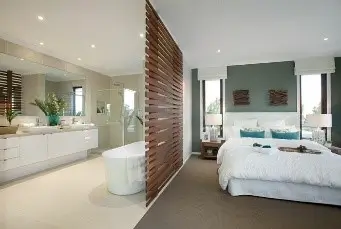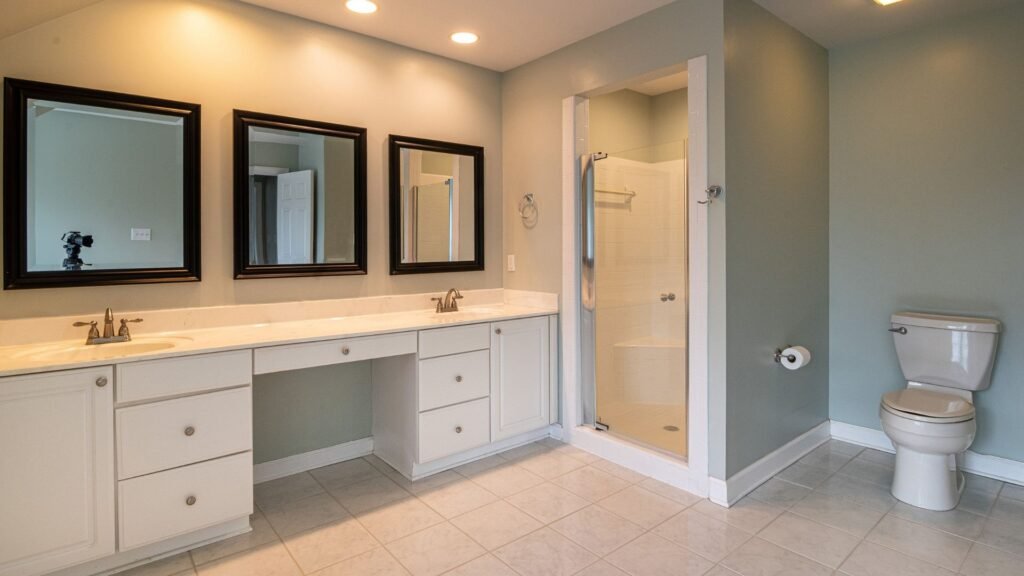Welcome to your go-to guide for tackling a bathroom renovation on a $10,000 budget. If you’re wondering whether that amount is enough to make a real difference, you’re not alone. Many homeowners face the same question when trying to balance cost, quality, and style. The good news? A $10K budget can go a long way if you plan smart, choose the right upgrades, and avoid common mistakes. In this post, you’ll get a clear breakdown of where the money goes, what upgrades are realistic, how to avoid budget traps, and practical tips to get the most out of every dollar.
Yes, you can renovate a bathroom for $10,000 by focusing on mid-range materials, keeping the layout the same, and handling some tasks yourself. Typical upgrades include a new vanity, toilet, basic tiles, updated lighting, and fresh paint. Careful budgeting and smart choices can help you achieve a functional and stylish bathroom within this price range.
Table of Contents
What Does a $10,000 Bathroom Renovation Look Like?
A $10,000 budget is often considered the sweet spot for a mid-range bathroom renovation. It gives you enough flexibility to make meaningful upgrades without overspending. But to make the most of it, you need to know exactly what that price tag typically includes and what it doesn’t.
Let’s break down what you can realistically expect at this budget level.
The Basics You Can Expect
A $10,000 bathroom remodel covers most of the essential upgrades that improve function, comfort, and appearance. Here’s what you can usually expect:
New Fixtures (Toilet, Sink, Vanity)
Replacing old fixtures is one of the fastest ways to make your bathroom feel new. You can upgrade to a modern toilet with water-saving features, a sleek vanity with storage, and a new sink that fits your style. Prefabricated vanities with built-in sinks are often more affordable than custom-built options and still look great.
Mid-Range Tiles or Vinyl Flooring
Flooring takes a lot of wear, so choosing a durable option is important. In this budget range, you can afford ceramic tiles, porcelain tiles, or quality vinyl plank flooring. These options offer a clean, stylish finish without the high cost of natural stone.
Fresh Paint or Wallpaper
A fresh coat of paint makes a big impact for very little money. Whether you go with neutral tones or bold colors, updated walls can instantly brighten the space. If you prefer something more decorative, peel-and-stick wallpaper is an affordable way to add texture or design.
Updated Lighting
Swapping out old light fixtures can dramatically change the room’s mood. You can expect to install new vanity lights, ceiling fixtures, or even energy-efficient LEDs. Stick to standard wiring and placements to avoid electrical upgrades that can push you over budget.
Standard Tub or Walk-In Shower
A new acrylic tub or a basic walk-in shower kit is usually within reach on a $10K budget. You might not be able to get a custom-tiled shower, but you can install a clean, functional unit with updated fixtures. This upgrade improves both usability and resale value.
What’s Not Usually Included
While $10,000 covers a lot, it doesn’t stretch far enough for high-end or highly customized changes. Here’s what typically falls outside this budget:
Major Layout Changes
Moving plumbing or changing the layout can be expensive. If you want to relocate the toilet, shower, or sink, the cost of reworking pipes and drainage systems can quickly eat up your entire budget. Keeping the layout the same is the best way to save.
High-End Materials
Luxury materials like marble countertops, designer tiles, or natural stone flooring are rarely possible at this price point. You’ll need to choose mid-range alternatives that mimic the look without the high price tag.
Custom Cabinetry
Custom-built cabinets or vanities cost significantly more than ready-to-install options. With a $10K limit, you’re better off choosing quality stock cabinetry that fits your space.
Luxury Items Like Heated Floors or Spa Tubs
Features like radiant heated floors, jetted tubs, or built-in Bluetooth speakers are nice to have, but they usually push the project beyond the $10,000 mark. These upgrades are better suited for higher-end renovations with larger budgets.
When planning your bathroom remodel, knowing these boundaries will help you make informed decisions and avoid surprises. Focus on the essentials, keep the layout intact, and choose quality over flash. That’s how you stay on budget and still walk away with a space that feels brand new.
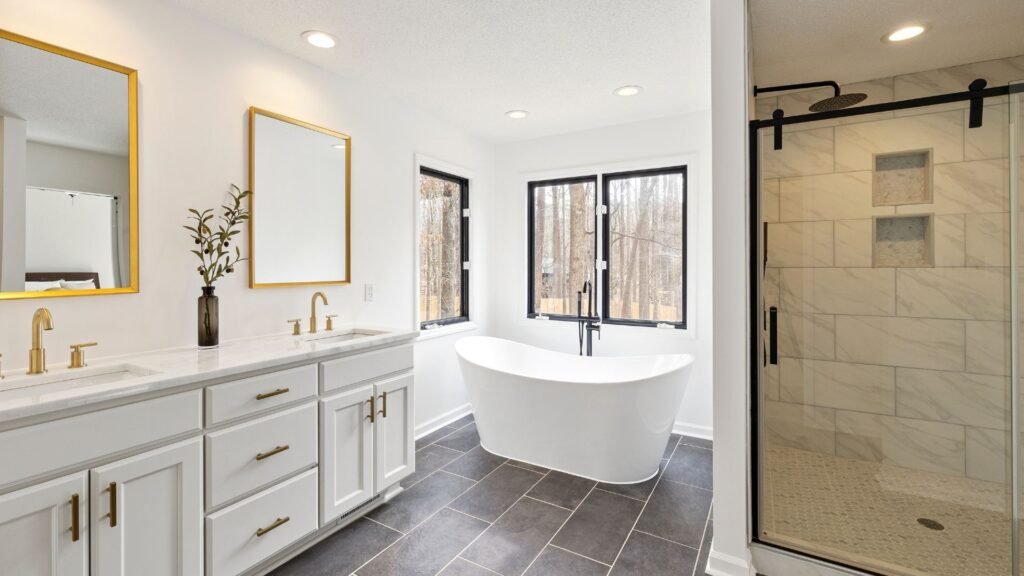
Where Does The Money Go? Cost Breakdown
When planning a bathroom renovation with a $10,000 budget, knowing exactly where your money goes helps you avoid overspending and make informed decisions. Every dollar matters. Breaking down the cost gives you a clear roadmap and prevents surprises during the project. Here’s what most homeowners can expect based on industry averages and real project data.
Average Allocation Of A $10K Budget
Labor: 30–50% ($3,000–$5,000)
Labor is usually the biggest part of your budget. This includes demolition, plumbing, electrical work, tiling, and installation. Hiring licensed professionals ensures everything is done safely and up to code. Even simple jobs can take days, so labor costs can quickly add up. To keep it under control, get multiple quotes, ask for fixed-rate pricing when possible, and clearly define what’s included in the quote.
Fixtures: 20–25% ($2,000–$2,500)
Fixtures include your toilet, vanity, sink, faucet, tub, or shower system. This range allows for quality, mid-tier items without going custom or luxury. For example, a solid wood vanity with a quartz top may cost around $800, while a basic but stylish toilet is available for $200–$300. Keep your eye on sales or combo packages that offer better value.
Tiles/Flooring: 10–15% ($1,000–$1,500)
Tiling is a visual focal point in most bathrooms. This budget covers floor tiles, shower walls, or backsplash areas. Prices vary depending on materials—ceramic and porcelain are usually affordable and durable. If you want to save more, vinyl plank flooring is a budget-friendly option that still looks good and resists water damage. Choose neutral colors and standard sizes to avoid high costs.
Plumbing & Electrical: 10% ($1,000)
Even if you’re not moving fixtures around, plumbing updates or minor reworks can be necessary. Replacing shut-off valves, installing new drains, or updating old electrical outlets (especially for GFCI compliance) is part of this category. Make sure your contractors are licensed, as poorly done work can lead to bigger issues later.
Paint, Lighting, Mirrors, Extras: 10% ($1,000)
This portion covers finishing touches. Paint freshens up walls and ceilings. Lighting makes a huge difference in both aesthetics and function. A well-placed mirror or new cabinet hardware can elevate the entire look. You don’t need to go overboard here—small changes often have a big visual impact.
Real Example (Optional)
Here’s a sample breakdown using actual prices from popular stores like IKEA and Home Depot to help you visualize how $10,000 might be spent:
| Category | Item | Estimated Cost |
| Vanity + Sink | GODMORGON/Odensvik Vanity (IKEA) | $499 |
| Toilet | Glacier Bay Dual-Flush (Home Depot) | $179 |
| Tub/Shower Kit | Sterling Ensemble Tub/Shower | $1,099 |
| Floor Tile | Ceramic Tile (60 sq. ft) | $420 |
| Wall Tile | Subway Tile (Shower Wall) | $600 |
| Paint + Supplies | Bathroom Paint, Brushes, Tape | $150 |
| Lighting Fixture | LED Vanity Light | $120 |
| Mirror | Flat Edge Mirror | $80 |
| Labor | General Contractor (Package Deal) | $4,800 |
| Contingency Buffer | For unforeseen costs | $1,000 |
This example proves that staying within a $10K budget is realistic when you choose mid-range products and plan your spending wisely. Always shop around, compare prices, and ask suppliers about discounts or bundles to get more value without overspending.
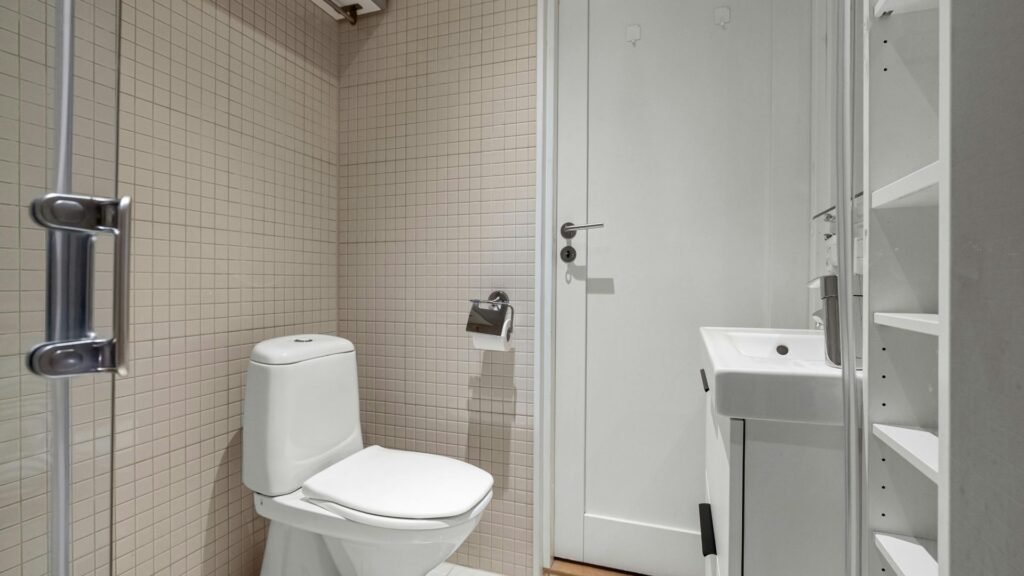
How To Stretch Your Budget Without Sacrificing Quality
Renovating a bathroom with a fixed $10,000 budget can feel limiting, but smart decisions can make it work without cutting corners. You don’t need to give up quality to stay on budget—you just need to know where to spend, where to save, and which projects you can take on yourself. Here’s how to get the most out of every dollar without compromising on function or style.
Prioritize What Matters
Before you shop for tiles or pick paint colors, focus on what your bathroom actually needs. A beautiful space means nothing if it doesn’t work properly.
Function Over Aesthetics
Start by fixing anything that’s broken, outdated, or unsafe. Leaky faucets, poor ventilation, or damaged flooring should always come first. These issues affect how the bathroom functions daily, and addressing them early can prevent bigger repair bills later.
Replace What’s Broken First
It’s tempting to go straight for cosmetic upgrades, but essentials should be your priority. If your toilet constantly runs or your tub is stained and cracked, those should top your list. Once the basics are covered, then you can look at visual improvements.
Keep The Layout The Same
Changing your bathroom’s layout—like moving the sink or toilet—may seem like a great idea, but it comes with a big price tag. Every time you relocate plumbing or electrical components, you add labor hours and increase the chance of costly surprises behind the walls.
No Plumbing Changes = Huge Savings
Keeping your sink, toilet, and shower in the same position helps you avoid hiring multiple trades and dealing with permits or inspections. That alone can save you thousands. Instead, update the fixtures in their current spots to give the space a fresh look without major construction.
Mix High And Low
Not everything in your bathroom needs to be high-end. In fact, blending affordable choices with a few standout features is one of the best ways to stay on budget without losing style.
Save On Tile Or Vanity, Splurge On Faucets Or Lighting
You can find stylish ceramic or porcelain tiles at budget-friendly prices, and stock vanities often look great with a new countertop or hardware. Use your savings to upgrade something that will get noticed—like a sleek faucet, designer mirror, or statement light fixture. These focal points elevate the whole room without costing a fortune.
Consider DIY (But Be Realistic)
Tackling parts of the project yourself can cut costs, but it’s important to choose your DIY battles wisely. Start with tasks that don’t require licenses or deep expertise.
Painting, Demo, Installing Mirrors Or Towel Racks
These are easy wins for DIYers. Removing old tiles, painting walls, or mounting accessories can save a few hundred dollars in labor. Just make sure you’re prepared with the right tools and a clear plan.
Know When To Hire A Pro (Tiling, Plumbing, Electrical)
Anything that involves water, electricity, or structural work should be left to professionals. Poor installation in these areas can lead to expensive damage and even safety risks. A licensed contractor ensures the work is done to code and protects your investment.
Making smart choices at every step can help you deliver a bathroom you love—without going over $10,000. Focus on what matters most, reuse where you can, and spend where it counts. This approach gives you both value and results without cutting quality.
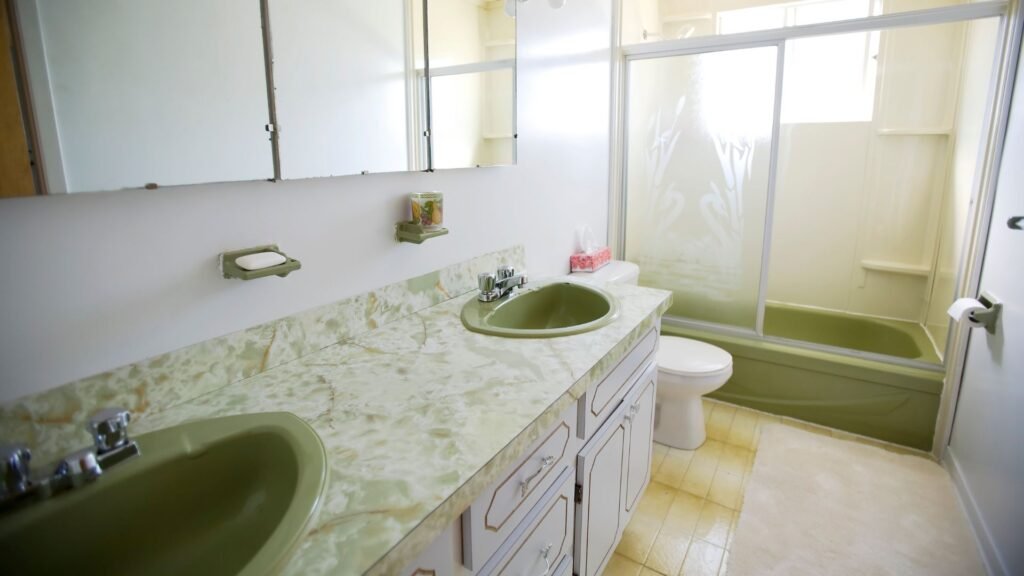
Common Budget Traps To Avoid
Renovating a bathroom on a $10,000 budget is possible—but only if you avoid the financial traps that often catch homeowners off guard. Most people don’t go over budget because they splurge on luxury tiles. It usually happens because they didn’t account for hidden costs or made decisions on the fly. Here are four of the most common budget traps and how to avoid them.
Underestimating Labor Costs
Labor is often the biggest expense in any renovation, especially when it comes to plumbing, electrical work, or tiling. Many homeowners focus on product costs—like vanities or tiles—without realizing that installation often costs just as much, if not more.
Contractors typically charge 30–50% of your total budget. So, if you’re working with $10,000, labor alone could take up $3,000 to $5,000. And that’s for straightforward jobs. If your bathroom has unusual dimensions or accessibility issues, you might need to pay more for extra time or skilled workers.
Tip: Get written quotes from at least three licensed professionals. Ask for a line-item breakdown so you understand exactly what you’re paying for.
Unexpected Repairs (Mold, Water Damage)
Behind those tiles and walls, your bathroom may be hiding problems. Water damage, mold, or rotting subfloors are surprisingly common—especially in older homes. These aren’t just cosmetic issues. They need to be fixed before any renovation work can continue.
For example, discovering mold behind a shower wall could cost an extra $500 to $1,500 in remediation alone. These hidden repairs can wipe out your contingency fund fast if you’re not prepared.
Tip: Always set aside 10–15% of your budget for unexpected repairs. Have a contractor do a pre-renovation inspection to catch red flags early.
Custom Orders Or Long Lead Times
It’s tempting to choose custom vanities, imported tiles, or one-of-a-kind fixtures to give your bathroom a high-end feel. But anything custom usually comes with higher costs and long wait times. This can lead to delays and extra charges if workers have to come back later or wait around for materials.
For example, a custom-made floating vanity might cost $2,000 more than a stock model—and take six to eight weeks to arrive. That delay could affect the availability of your contractor or push your project into a new billing cycle.
Tip: Stick to in-stock or standard-size items from reliable suppliers. Look for budget-friendly materials that still offer style without the wait.
Upgrades That Creep Up Mid-Project
You start with a plan. Then midway through the project, you decide to upgrade to marble counters, switch out lighting, or add underfloor heating. These spontaneous changes—also known as “scope creep”—can break your budget fast.
Each change adds time, materials, and labor. And because you’re already mid-project, you may feel pressured to approve the costs quickly without thinking through the long-term impact.
Tip: Set your priorities before the project begins. Create a “must-have” and “nice-to-have” list. Stick to your plan unless something absolutely needs to change.
Avoiding these common budget traps isn’t just about saving money—it’s about keeping your renovation on track and stress-free. The more prepared you are, the smoother your $10,000 bathroom remodel will be. Want to see where your money will go before you start? Try building a simple cost tracker to stay in control from day one.
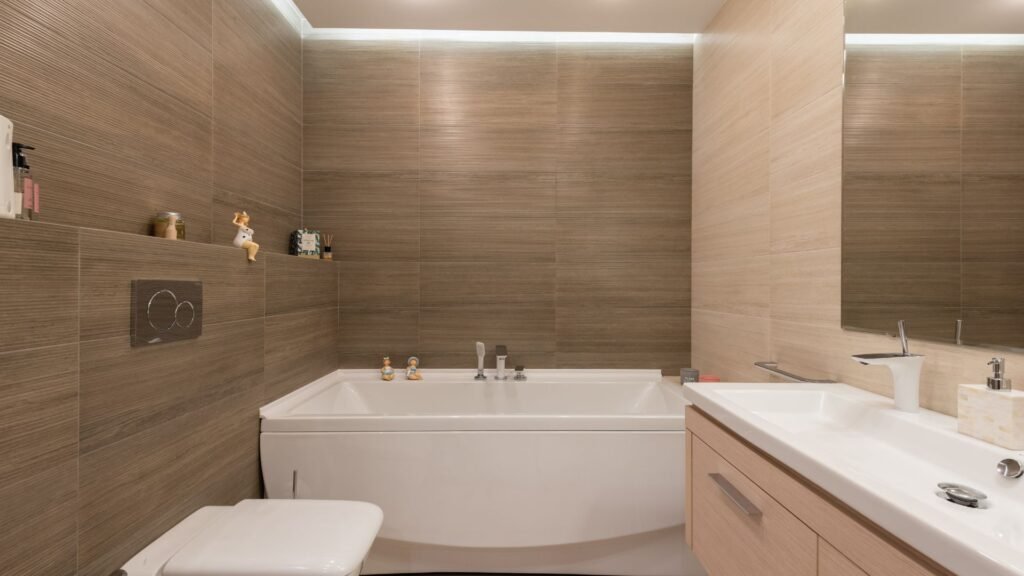
5 Smart Tips To Stay On Budget
Renovating a bathroom on a $10,000 budget is absolutely doable, but only if you stay organized and make smart decisions along the way. Costs can add up quickly—especially when surprises pop up. That’s why a proactive approach to budgeting is one of the most valuable tools you have. Below are five practical tips to help you avoid overspending while still getting a finished space you’re happy with.
Get Multiple Quotes Before Hiring
Never settle for the first estimate you receive. Every contractor prices jobs differently based on experience, overhead, and workload. By comparing at least three quotes, you’ll get a better sense of what the job should cost. You’ll also spot any outliers—both high and low. Be sure to ask exactly what’s included in each quote, so you’re not caught off guard by hidden fees or vague labor descriptions. Taking this step could save you hundreds—or even thousands—right from the start.
Ask Contractors For Budget-Friendly Suggestions
Good contractors aren’t just there to do the work. They often have valuable insights on how to reduce costs without cutting corners. Don’t be afraid to ask for alternatives. For example, can you use a pre-fabricated shower instead of custom tile? Can you refinish your existing vanity instead of buying new? A contractor with experience can suggest workarounds that maintain quality while trimming the price.
Shop Sales Or Look At Second-Hand Items
High-quality doesn’t always mean high-price. Retailers often run seasonal sales on bathroom items like vanities, faucets, and tiles. Sign up for store newsletters, watch clearance sections, and don’t overlook local building supply stores or reuse centers. You can often find gently used or overstock items for a fraction of the retail cost. With some digging, you might score a $600 vanity for half the price—without sacrificing style.
Add A 10–15% Buffer For Surprises
Even the most well-planned renovation can hit a few bumps. Maybe there’s hidden water damage behind the walls. Maybe your subfloor needs replacing. These are the kinds of issues you won’t know about until demo day. That’s why it’s smart to set aside 10 to 15 percent of your total budget as a cushion. If you don’t need it, great. But if you do, you won’t be scrambling to come up with extra cash midway through the project.
Use Online Tools Or Spreadsheets To Track Every Dollar
One of the easiest ways to blow your budget is to lose track of small expenses. A few impulse buys or last-minute upgrades can snowball fast. Use a basic spreadsheet, renovation app, or budget tracker to log every cost—from contractor fees to paint brushes. This gives you a clear view of what’s left to spend and where you might need to adjust. Seeing the numbers in real time helps you stay accountable and make informed choices.
Following these five tips won’t just keep your renovation on budget—they’ll give you more control and confidence throughout the entire process. When every dollar counts, small decisions can make a big difference.
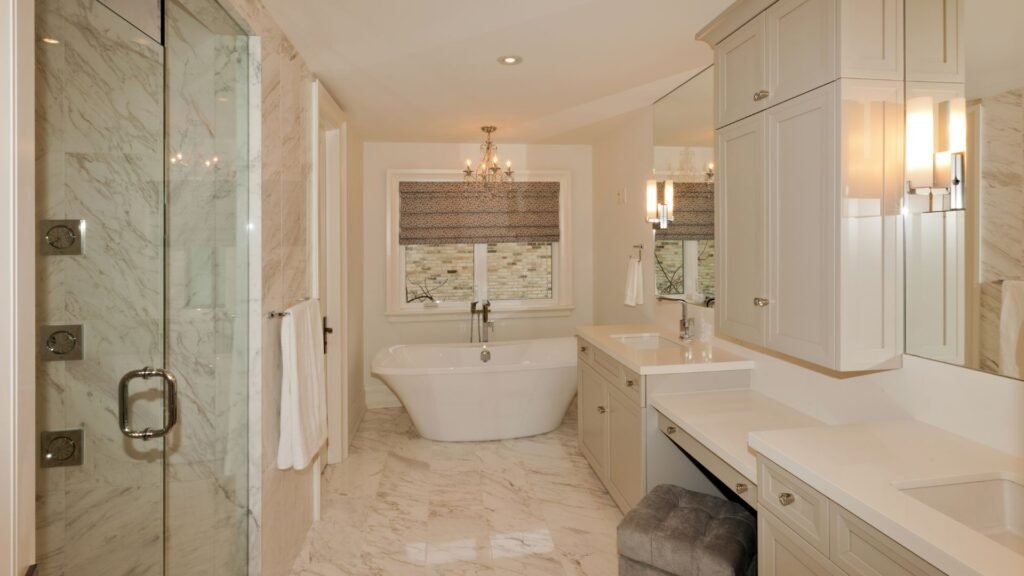
Is A $10K Bathroom Renovation Worth It?
Renovating your bathroom is one of the smartest updates you can make to your home. But when you’re working with a fixed $10,000 budget, it’s natural to wonder if it’s really worth the investment. The short answer is yes—if you spend it wisely.
A $10K bathroom renovation won’t give you spa-level luxury, but it can deliver solid upgrades that boost both daily functionality and property value. Whether you’re improving a guest bath or updating your primary bathroom, thoughtful upgrades can make a noticeable difference without breaking the bank.
ROI On Mid-Range Bathroom Remodels
A mid-range bathroom remodel has one of the best returns on investment among home improvement projects. According to Remodeling Magazine’s Cost vs. Value Report, homeowners typically recoup 60% to 70% of the renovation cost when they sell. That means your $10K remodel could potentially add $6,000 to $7,000 in value to your home.
But ROI isn’t just about resale value. A well-executed renovation also improves everyday comfort, which matters just as much—if not more—when you’re living in the home.
Here’s what a $10K upgrade can realistically improve:
- Resale Value: Buyers notice updated bathrooms. Clean fixtures, modern lighting, and fresh finishes can set your listing apart.
- Daily Comfort: Replacing an old toilet, fixing plumbing issues, or upgrading poor lighting directly impacts how the space feels day to day.
- Curb Appeal Indoors: Even budget-friendly design choices—like neutral tiles or a sleek vanity—can modernize the look and feel of your bathroom.
If you’re planning to sell your home in the next few years, an updated bathroom can give you an edge in a competitive market. Even small changes like new hardware, mirrors, or lighting can make a room feel newer and more appealing to buyers.
When To Save Vs. When To Wait
Sometimes, the smartest choice is not to spend your full budget all at once. A $10K renovation can solve practical issues and improve style, but it’s not right for every situation. Think about your long-term plans and how much of the bathroom really needs attention.
Here’s when it makes sense to renovate now:
- Your current bathroom has water damage, mold, or outdated plumbing.
- Fixtures like the toilet, tub, or sink are broken or inefficient.
- You’re planning to sell and need a quick refresh to increase appeal.
- You can improve the space significantly with basic upgrades like paint, tile, and lighting.
And here’s when it might be better to wait:
- You want a custom layout or luxury finishes that will exceed $10K.
- Your home’s value doesn’t support a big renovation at this time.
- You’d rather save more to complete a high-end remodel in one go.
You don’t always have to choose between spending now or doing nothing. Some homeowners tackle key upgrades today—like plumbing and electrical—then wait a year or two to add premium features. That way, you still make progress without overspending.
In the end, a $10,000 bathroom remodel is worth it if the upgrades solve real problems, add comfort, and give your home a cleaner, modern look. Think of it as an investment in both your lifestyle and your property’s future value.

Sample $10K Bathroom Renovation Plan
If you’re working with a $10,000 budget for a bathroom remodel, knowing exactly where the money goes is critical. This sample plan breaks down each category of the renovation to help you understand how a modest budget can still deliver quality results. Whether you’re planning a guest bathroom update or a small main bath refresh, this realistic guide will help you prioritize and make smart decisions.
Here’s a full explanation of each line item in the $10K sample renovation plan:
Vanity + Sink – $1,000
A 36” prefab vanity with a built-in sink and countertop is both cost-effective and functional. Prefab models are widely available at major retailers like Home Depot or Lowe’s. Most come with standard faucet holes, making installation easier and cheaper. This budget includes a mid-range faucet and any necessary hardware. You’re not getting custom cabinetry at this price, but the result will still look clean and modern.
Toilet – $300
A standard dual-flush toilet helps save water and meets modern efficiency standards. Most models in this price range are durable, easy to clean, and come with simple installation instructions. Opting for a white ceramic finish keeps costs low and fits almost any design style.
Tub/Shower – $2,000
This covers a basic acrylic bathtub and tiled surround or an acrylic shower stall with simple finishes. Acrylic is a smart material choice—it’s affordable, lightweight, and easy to maintain. Labor for installation is included in the overall labor cost listed later. Custom shower designs or luxury materials will push this category over budget, so staying with standard options is key.
Flooring – $800
Vinyl plank and ceramic tile are two popular and practical choices in this price range. Vinyl is waterproof, soft underfoot, and quicker to install. Ceramic tile offers a more polished finish but comes with higher installation costs. Either material holds up well in wet environments, and $800 is enough to cover both product and installation in most small-to-medium bathrooms.
Labor – $4,000
Labor typically takes up the largest portion of a bathroom renovation budget. This includes demolition, plumbing, electrical work, tiling, and finishing tasks. Hiring qualified contractors ensures the job meets code requirements and prevents costly mistakes. In this budget, you’ll likely need to limit custom work and keep the project simple to stay within the $4,000 labor cap.
Paint + Lighting – $900
A fresh coat of paint instantly modernizes a bathroom and helps resist moisture with the right finish. This budget also covers basic LED ceiling lights, a wall-mounted vanity light, and a functional mirror. Avoid expensive designer fixtures; instead, focus on simple, clean lines that complement the space. Choosing energy-efficient lighting will save money in the long run.
Buffer – $1,000
A 10% buffer is crucial for any renovation project. Unexpected expenses like minor plumbing repairs, material delivery fees, or changes in fixture availability can add up fast. Including this buffer from the start helps avoid overspending and keeps your project running smoothly.
This renovation plan keeps the scope realistic and avoids luxury upgrades that quickly push costs above the $10K mark. If you’re renovating on a tight budget, every dollar counts—and with smart planning, you can transform your bathroom without overspending. Want help putting together a shopping list or finding budget fixtures that fit your style? Just ask.

Real People, Real Renovations
One of the best ways to understand what a $10,000 bathroom renovation looks like in real life is by hearing from actual homeowners who’ve done it. These stories give you honest insights—what worked, what didn’t, and where the money actually went. Real-life experiences help set realistic expectations and offer creative ideas you might not have considered.
Bathroom remodels vary widely based on the home’s condition, region, material choices, and the homeowner’s priorities. But one thing is clear: many people have successfully updated their bathrooms without going over a $10K budget. Here are a few examples that show how they made it work.
“I saved $2,000 just by reusing my old vanity and repainting it.”
Sarah, a homeowner in Oregon, had a simple goal—modernize her outdated bathroom without spending a fortune. Instead of replacing her old vanity, she gave it a facelift with a coat of durable paint and new hardware. The result looked fresh and modern, and the savings helped her splurge on a frameless glass shower door. She focused on function, skipped fancy upgrades, and made practical design choices.
“Keeping the original layout saved me thousands in plumbing costs.”
Jason from Texas tackled a full renovation in a 1980s bathroom. By keeping the sink, toilet, and tub in the same spots, he avoided expensive plumbing changes. This allowed him to use higher-quality tiles and lighting while staying under budget. His tip? Don’t move what works—just upgrade the parts that look tired.
“I bought my tiles and fixtures during clearance sales and saved big.”
Emily in New Jersey kept her remodel budget around $9,500 by shopping early and taking advantage of seasonal sales. She bought her tiles, mirror, and vanity on clearance from local hardware stores. By planning ahead and being flexible with style, she found premium-quality items at a fraction of the cost.
“We did all the demo ourselves over one weekend.”
A couple in Colorado took on the demolition work themselves to save on labor. They removed old tiles, stripped the walls, and pulled out the old bathtub. This saved about $1,200 in demo costs, which they used to upgrade to a dual-flush toilet and recessed lighting. While it took time and effort, they said it was worth it.
What You Can Learn From These Stories
Reuse when possible. A fresh coat of paint or new handles can make an old fixture feel new.
Plan around the layout. Changing plumbing costs more than it’s worth in most mid-range remodels.
Shop smart. Clearance sales, open-box items, and online deals can stretch your dollars further.
Do what you can yourself. Basic demo or painting tasks can shave off hundreds or thousands.
These real renovations prove that a $10,000 bathroom remodel isn’t just possible—it’s doable without sacrificing style or comfort. With careful choices, a clear plan, and a willingness to be flexible, you can create a space that looks great and functions well within your budget.
Ready to plan your bathroom remodel on a $10K budget? Visit Bathroom Renovation Hamilton to explore renovation tips, trusted contractor guides, and affordable upgrade ideas to get started.
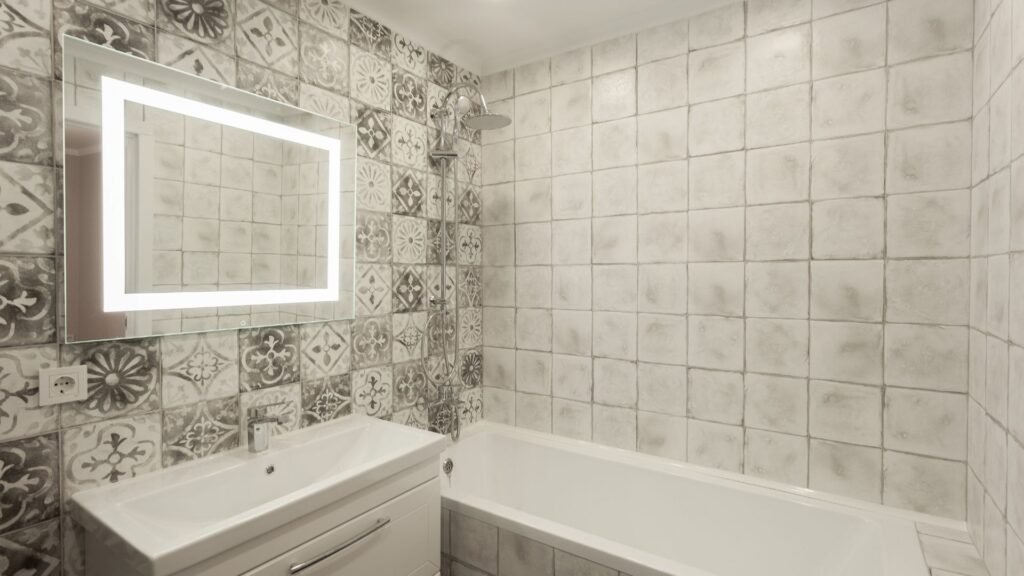
FAQs: Can I Renovate My Bathroom For $10,000?
Can I really renovate a bathroom for $10,000?
Yes, a $10,000 budget can cover a basic to mid-range bathroom renovation if you plan carefully. This includes new fixtures, flooring, paint, lighting, and labor. Avoiding layout changes and luxury upgrades is key to staying within budget.
What’s the average cost of a bathroom renovation?
In the U.S., a standard bathroom remodel typically ranges from $8,000 to $15,000. High-end remodels can exceed $25,000, while budget-friendly ones can stay under $10,000 with smart planning.
How can I keep my renovation costs under control?
Stick to the existing layout, choose mid-range materials, and prioritize essential upgrades. Get multiple quotes, track your spending, and include a 10–15% buffer for surprises.
What upgrades should I prioritize on a $10,000 budget?
Focus on functional upgrades like a new vanity, toilet, tub or shower, and flooring. Lighting, paint, and updated hardware can enhance the look without high costs.
Is it cheaper to renovate a small bathroom?
Yes. A smaller space means fewer materials and less labor, which can help you stay within a lower budget. However, costs per square foot may still be high due to plumbing and fixtures.
Can I DIY parts of the bathroom renovation?
Yes, you can handle painting, demolition, or installing accessories like mirrors and shelves. Leave plumbing, electrical, and tiling to licensed professionals to avoid costly mistakes.
Are permits needed for a $10,000 bathroom remodel?
It depends on your location and the scope of work. Simple cosmetic changes usually don’t require permits, but plumbing, electrical, and structural changes often do. Check with your local building authority.
What are common hidden costs in bathroom renovations?
Unexpected issues like water damage, mold, or outdated plumbing can add to the cost. Always include a buffer in your budget for these surprises.
Should I hire a general contractor or manage the project myself?
If you’re managing multiple trades (plumber, electrician, tiler), a general contractor can save time and reduce stress. For small projects or partial DIY, managing it yourself may be more cost-effective.
Does a $10K bathroom remodel add value to my home?
Yes. A well-done, mid-range remodel can improve comfort and increase resale value. Bathrooms are key selling points, and buyers often look for clean, updated spaces.
Conclusion
Yes, you can renovate your bathroom for $10,000—if you plan smart. This budget is enough for a functional and stylish upgrade when you focus on the essentials, avoid unnecessary changes, and make careful spending decisions. Start by identifying your priorities, like improving your shower, adding storage, or updating lighting. Shop wisely by comparing prices, hunting for discounts, and considering second-hand or clearance items. Avoid scope creep by sticking to your original plan, especially if you’re hiring contractors, since mid-project changes can quickly drive up costs. A well-managed $10K renovation can improve your daily routine, add value to your home, and give you a space that feels fresh and updated. Got a $10K budget? Start by pricing your must-haves and talking to a pro.




